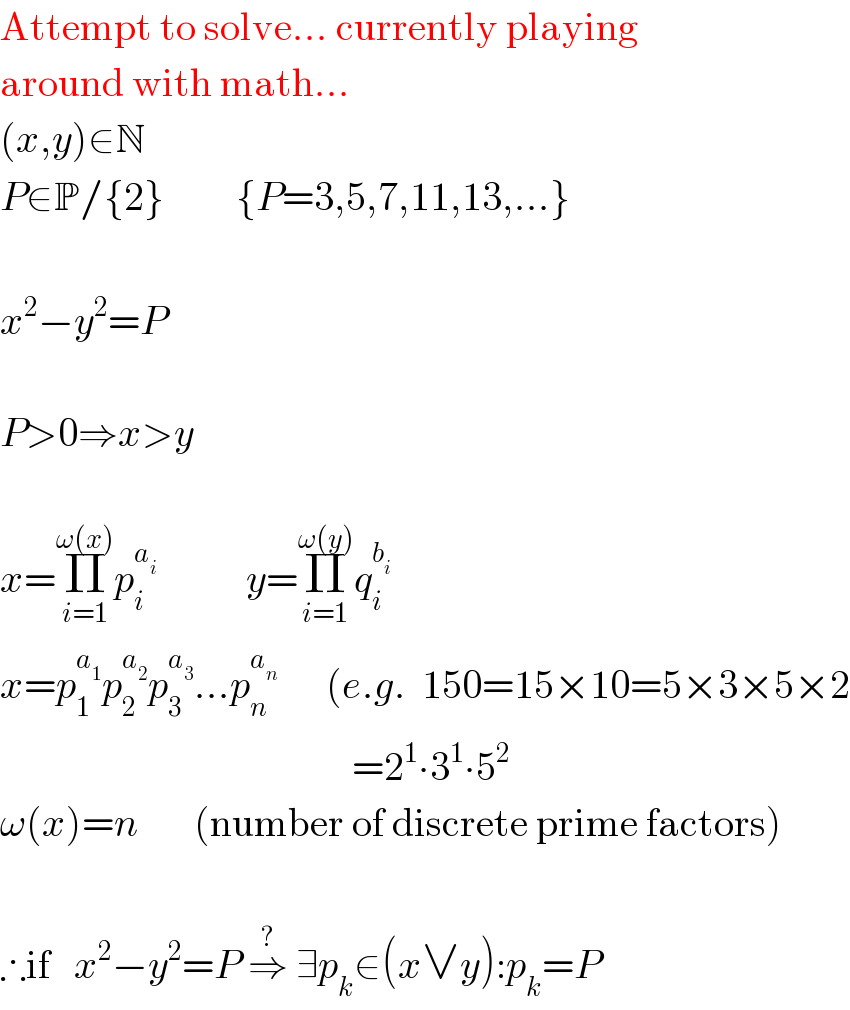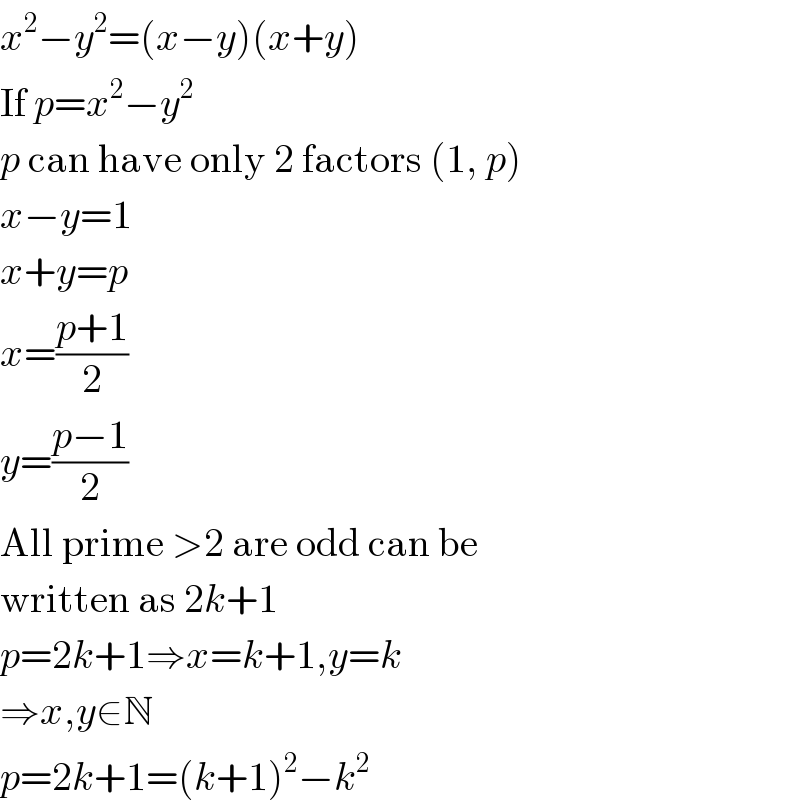
Question Number 8027 by Nayon last updated on 28/Sep/16

$${prove}\rightarrow\:{any}\:{prime}\:{number}>\mathrm{2}\: \\ $$ $${can}\:{be}\:{written}\:{into}\left(\:{x}^{\mathrm{2}} −{y}^{\mathrm{2}\:} \right)\:{where} \\ $$ $$\left({x},{y}\right)\in{N} \\ $$
Commented byFilupSmith last updated on 28/Sep/16

$$\mathrm{Attempt}\:\mathrm{to}\:\mathrm{solve}...\:\mathrm{currently}\:\mathrm{playing} \\ $$ $$\mathrm{around}\:\mathrm{with}\:\mathrm{math}... \\ $$ $$\left({x},{y}\right)\in\mathbb{N} \\ $$ $${P}\in\mathbb{P}/\left\{\mathrm{2}\right\}\:\:\:\:\:\:\:\:\:\left\{{P}=\mathrm{3},\mathrm{5},\mathrm{7},\mathrm{11},\mathrm{13},...\right\} \\ $$ $$\: \\ $$ $${x}^{\mathrm{2}} −{y}^{\mathrm{2}} ={P} \\ $$ $$\: \\ $$ $${P}>\mathrm{0}\Rightarrow{x}>{y} \\ $$ $$ \\ $$ $${x}=\underset{{i}=\mathrm{1}} {\overset{\omega\left({x}\right)} {\prod}}{p}_{{i}} ^{{a}_{{i}} } \:\:\:\:\:\:\:\:\:\:\:{y}=\underset{{i}=\mathrm{1}} {\overset{\omega\left({y}\right)} {\prod}}{q}_{{i}} ^{{b}_{{i}} } \\ $$ $${x}={p}_{\mathrm{1}} ^{{a}_{\mathrm{1}} } {p}_{\mathrm{2}} ^{{a}_{\mathrm{2}} } {p}_{\mathrm{3}} ^{{a}_{\mathrm{3}} } ...{p}_{{n}} ^{{a}_{{n}} } \:\:\:\:\:\:\left({e}.{g}.\:\:\mathrm{150}=\mathrm{15}×\mathrm{10}=\mathrm{5}×\mathrm{3}×\mathrm{5}×\mathrm{2}\right. \\ $$ $$\:\:\:\:\:\:\:\:\:\:\:\:\:\:\:\:\:\:\:\:\:\:\:\:\:\:\:\:\:\:\:\:\:\:\:\:\:\:\:\:\:\:\:\:=\mathrm{2}^{\mathrm{1}} \centerdot\mathrm{3}^{\mathrm{1}} \centerdot\mathrm{5}^{\mathrm{2}} \\ $$ $$\omega\left({x}\right)={n}\:\:\:\:\:\:\:\left(\mathrm{number}\:\mathrm{of}\:\mathrm{discrete}\:\mathrm{prime}\:\mathrm{factors}\right) \\ $$ $$ \\ $$ $$\therefore\mathrm{if}\:\:\:{x}^{\mathrm{2}} −{y}^{\mathrm{2}} ={P}\:\overset{?} {\Rightarrow}\:\exists{p}_{{k}} \in\left({x}\vee{y}\right):{p}_{{k}} ={P} \\ $$
Answered by prakash jain last updated on 28/Sep/16

$${x}^{\mathrm{2}} −{y}^{\mathrm{2}} =\left({x}−{y}\right)\left({x}+{y}\right) \\ $$ $$\mathrm{If}\:{p}={x}^{\mathrm{2}} −{y}^{\mathrm{2}} \\ $$ $${p}\:\mathrm{can}\:\mathrm{have}\:\mathrm{only}\:\mathrm{2}\:\mathrm{factors}\:\left(\mathrm{1},\:{p}\right) \\ $$ $${x}−{y}=\mathrm{1} \\ $$ $${x}+{y}={p} \\ $$ $${x}=\frac{{p}+\mathrm{1}}{\mathrm{2}} \\ $$ $${y}=\frac{{p}−\mathrm{1}}{\mathrm{2}} \\ $$ $$\mathrm{All}\:\mathrm{prime}\:>\mathrm{2}\:\mathrm{are}\:\mathrm{odd}\:\mathrm{can}\:\mathrm{be} \\ $$ $$\mathrm{written}\:\mathrm{as}\:\mathrm{2}{k}+\mathrm{1} \\ $$ $${p}=\mathrm{2}{k}+\mathrm{1}\Rightarrow{x}={k}+\mathrm{1},{y}={k} \\ $$ $$\Rightarrow{x},{y}\in\mathbb{N} \\ $$ $${p}=\mathrm{2}{k}+\mathrm{1}=\left({k}+\mathrm{1}\right)^{\mathrm{2}} −{k}^{\mathrm{2}} \\ $$
Commented byFilupSmith last updated on 29/Sep/16

$$\mathrm{i}\:\mathrm{forgot}\:{x}^{\mathrm{2}} −{y}^{\mathrm{2}} =\left({x}−{y}\right)\left({x}+{y}\right)\:\:\:{haha} \\ $$
